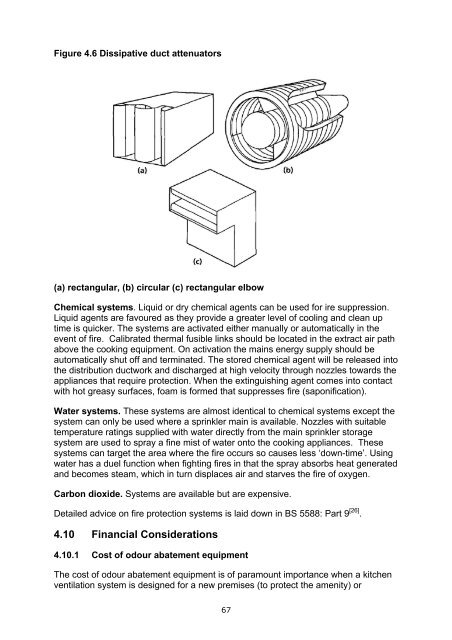Guidance on the Control of Odour and Noise from ... - Defra
Guidance on the Control of Odour and Noise from ... - Defra
Guidance on the Control of Odour and Noise from ... - Defra
You also want an ePaper? Increase the reach of your titles
YUMPU automatically turns print PDFs into web optimized ePapers that Google loves.
Figure 4.6 Dissipative duct attenuators<br />
(a) rectangular, (b) circular (c) rectangular elbow<br />
Chemical systems. Liquid or dry chemical agents can be used for ire suppressi<strong>on</strong>.<br />
Liquid agents are favoured as <strong>the</strong>y provide a greater level <strong>of</strong> cooling <strong>and</strong> clean up<br />
time is quicker. The systems are activated ei<strong>the</strong>r manually or automatically in <strong>the</strong><br />
event <strong>of</strong> fire. Calibrated <strong>the</strong>rmal fusible links should be located in <strong>the</strong> extract air path<br />
above <strong>the</strong> cooking equipment. On activati<strong>on</strong> <strong>the</strong> mains energy supply should be<br />
automatically shut <strong>of</strong>f <strong>and</strong> terminated. The stored chemical agent will be released into<br />
<strong>the</strong> distributi<strong>on</strong> ductwork <strong>and</strong> discharged at high velocity through nozzles towards <strong>the</strong><br />
appliances that require protecti<strong>on</strong>. When <strong>the</strong> extinguishing agent comes into c<strong>on</strong>tact<br />
with hot greasy surfaces, foam is formed that suppresses fire (sap<strong>on</strong>ificati<strong>on</strong>).<br />
Water systems. These systems are almost identical to chemical systems except <strong>the</strong><br />
system can <strong>on</strong>ly be used where a sprinkler main is available. Nozzles with suitable<br />
temperature ratings supplied with water directly <strong>from</strong> <strong>the</strong> main sprinkler storage<br />
system are used to spray a fine mist <strong>of</strong> water <strong>on</strong>to <strong>the</strong> cooking appliances. These<br />
systems can target <strong>the</strong> area where <strong>the</strong> fire occurs so causes less ‘down-time’. Using<br />
water has a duel functi<strong>on</strong> when fighting fires in that <strong>the</strong> spray absorbs heat generated<br />
<strong>and</strong> becomes steam, which in turn displaces air <strong>and</strong> starves <strong>the</strong> fire <strong>of</strong> oxygen.<br />
Carb<strong>on</strong> dioxide. Systems are available but are expensive.<br />
Detailed advice <strong>on</strong> fire protecti<strong>on</strong> systems is laid down in BS 5588: Part 9 [26] .<br />
4.10 Financial C<strong>on</strong>siderati<strong>on</strong>s<br />
4.10.1 Cost <strong>of</strong> odour abatement equipment<br />
The cost <strong>of</strong> odour abatement equipment is <strong>of</strong> paramount importance when a kitchen<br />
ventilati<strong>on</strong> system is designed for a new premises (to protect <strong>the</strong> amenity) or<br />
67
















